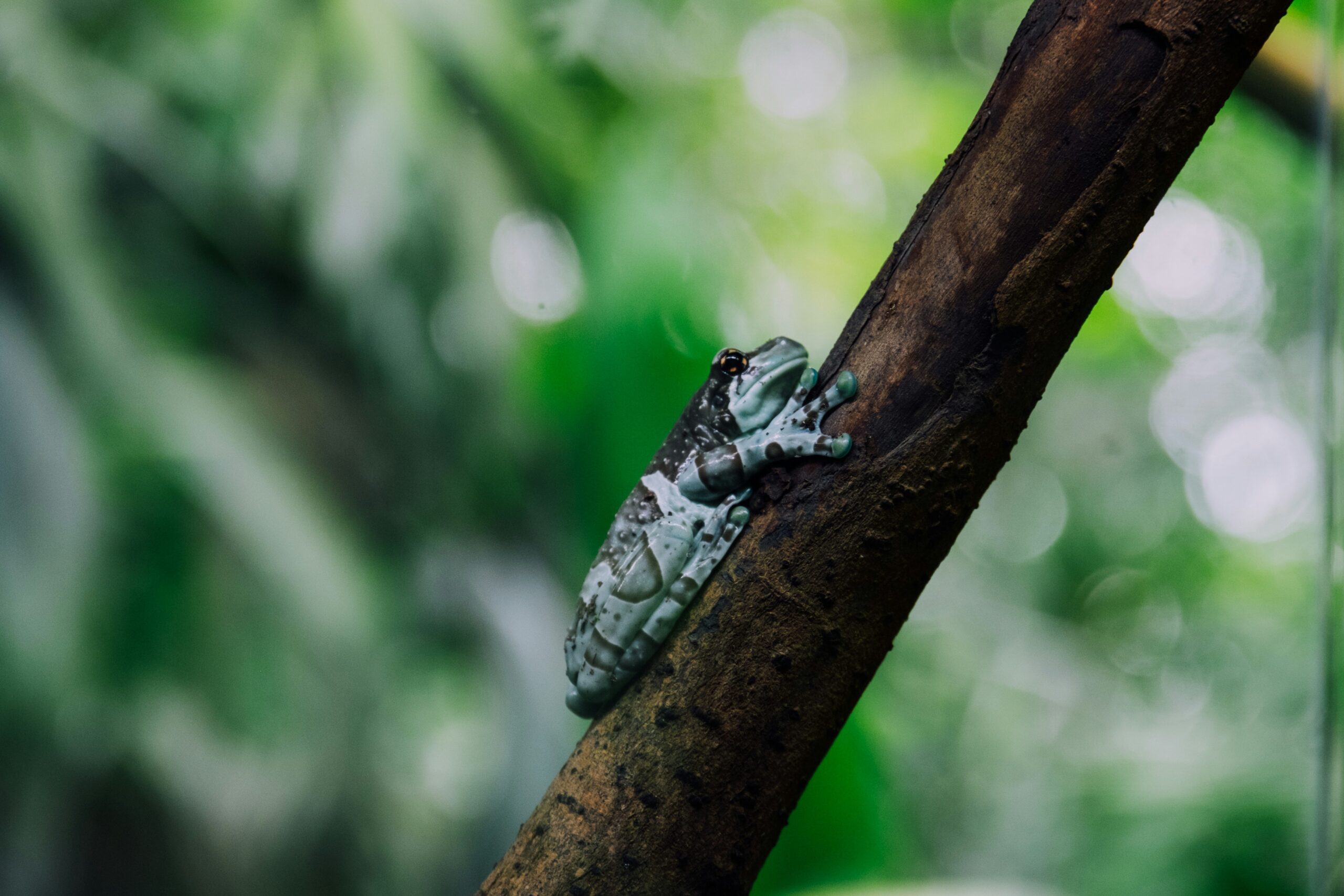Trachycephalus resinifictrix
Species Overview
Amazon Milk Frogs are arboreal hylids native to the humid lowland rainforests of the Amazon Basin. Their distinctive pale-blue feet and brown-and-cream banding make them striking display animals, while a waxy skin secretion (once thought to resemble milk) helps reduce water loss. Captive-bred individuals are hardy, reasonably docile, and tolerant of small groups when space is adequate.
Care Level: Beginner to Intermediate
Adult Size: 3–4 in (7.5–10 cm)
Average Lifespan: 8–15 years in captivity
Activity Pattern: Nocturnal
Temperament: Calm; handle sparingly
Enclosure Setup
Amazon Milk Frogs thrive in tall, well-ventilated enclosures that maintain high humidity but allow ample airflow. A bioactive, plant-dense environment supports natural behaviors and simplifies maintenance.
Minimum Size: 18 × 18 × 24 in front-opening terrarium for 2 adults
Substrate: Moisture-retentive base such as coconut fiber blended with sphagnum moss or a full ABG mix over LECA drainage
Structural Elements:
Resin or cork branchwork for vertical climbing
Large leaf plants (pothos, philodendron, bromeliads) for cover and perching
Horizontal cork tubes near the canopy as daytime retreats
Water Source: Wide, shallow dish of dechlorinated water; change daily
Environmental Parameters
Day Temperature: 74–80 °F (23–27 °C)
Night Temperature: 68–75 °F (20–24 °C)
Humidity: 70–90 %; automated or twice-daily misting recommended
Lighting: Low-level UVB (5.0 T5) plus full-spectrum LED for a 12-h photoperiod
Diet and Feeding
Opportunistic insectivores that benefit from dietary variety and regular supplementation.
Staple Prey: Gut-loaded crickets and dubia roaches
Additional Items: Black soldier fly larvae, small silkworms, occasional waxworms as treats
Feeding Frequency: Juveniles daily; adults every 2–3 days
Supplements: Calcium + D3 twice weekly; multivitamin once weekly
Maintenance and Hygiene
Daily: Remove uneaten prey and waste; refresh water dish
Weekly: Wipe glass and rinse foliage to prevent bacterial film
Monthly: Refresh substrate layer or service bioactive cleanup crew
Water Quality: Always use dechlorinated or spring water
Behavior and Handling
Primarily canopy dwellers; they spend daylight hours tucked into foliage or cork retreats and become active at dusk. Handle only when necessary, with clean, wet hands or nitrile gloves to protect their sensitive skin.
Breeding Information
Sexually mature at 12–18 months. Breeding is triggered by increased rainfall simulation and a slight temperature drop. Females deposit egg masses on vegetation over water; tadpoles fall into the pool below and require warm, well-filtered water and high-quality micro diets.
Health Considerations
Chytridiomycosis: Prevent with strict quarantine and stable humidity
Bacterial dermatitis: Maintain clean, well-ventilated habitat
Nutritional deficits: Adhere to supplementation schedule
Seek an experienced exotic veterinarian for any signs of lethargy, skin lesions, or inappetence.
Recommended Supplies
Vertical glass terrarium (18 × 18 × 24 in or larger)
Digital thermometer / hygrometer combo
Coconut fiber–sphagnum or ABG substrate over LECA drainage
Live rainforest plants and cork décor
Shallow water bowl (dechlorinated water)
Low-level UVB fixture + LED plant light
Calcium with D3 and multivitamin powder
Pressurized misting system or hand sprayer
Hunter’s Tip
Anchor pothos cuttings high in the enclosure; trailing vines create natural hunting platforms and boost humidity without blocking ventilation.
Fun Facts
Their “milk” secretion is actually a mild toxin that deters predators and reduces desiccation.
Amazon Milk Frogs vocalize with a distinctive chuckling call during the rainy season.
Toe pads contain ultra-fine keratin layers that let them cling securely even to wet glass.
Hunter’s Picks
MistKing Misting System — Precise automated misting keeps humidity in the optimal 70–90 % range.
Reptizoo Mister (Budget) — Cost-effective humidity control for smaller setups.
Repti Calcium with D3 — Critical for preventing metabolic bone disease in fast-growing juveniles.
Reptizoo Hygrometer & Thermometer — Real-time monitoring of temperature and humidity.
Coconut Soil & Sphagnum Moss — Ideal substrate blend for moisture retention and bioactivity.
Reptizoo Front-Opening Terrarium — Secure, spacious vertical enclosure designed for arboreal species.
LECA (Lightweight Expanded Clay Aggregate) — Ideal for drainage layers in amphibian and reptile terrariums to prevent waterlogging and promote healthy root systems in live plants.
Cork Bark — Naturalistic climbing and hiding spots for frogs, reptiles, and other terrarium inhabitants. Durable and easy to clean.
Live Plants from Josh’s Frogs (10 Gallon Size) — High-quality live plants selected for terrarium environments, enhancing natural aesthetics and air quality.
Water Conditioner — Removes harmful chemicals and chlorine from tap water, making it safe for amphibians and reptiles. Essential for water dish and misting water prep.
Window Screen — Durable mesh material used to cover drainage layers and prevent substrate mixing, also suitable for terrarium ventilation.
Reptizoo LED UVB Light — Suitable UVB lighting designed specifically for amphibians; provides necessary UV exposure without overheating the enclosure.
Purchasing through these affiliate links helps support Hunter’s Exotics at no additional cost to you. Thank you!



